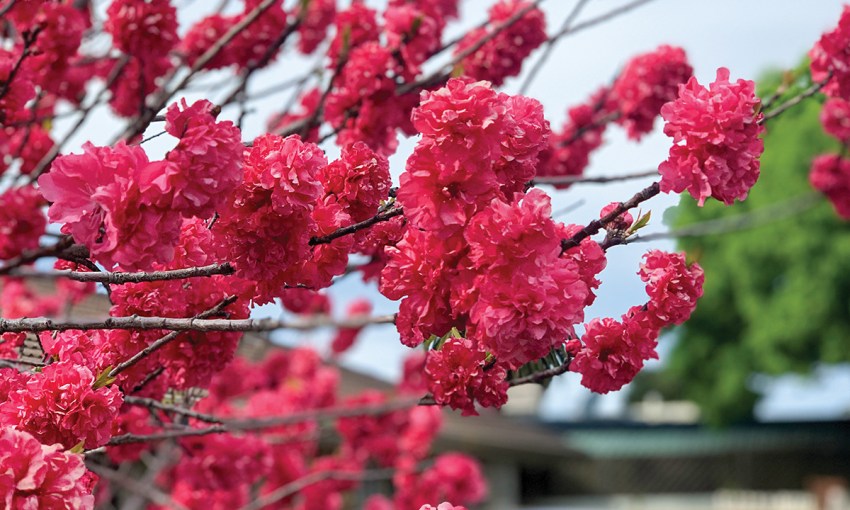Bewitching fruit tree blossoms are the herald of spring. Surely every garden needs at least one?
Spring blossoms: Fleeting beauty
Blossom … it is beautiful but, alas, it is fleeting! Generally, the blossoms themselves last only a couple of weeks, but the anticipation begins when the tight buds appear at the end of winter or early spring and then, slowly, as the weather gets warmer, they start to open to reveal a mass of flowers – transforming your garden into a vision of loveliness.
The purpose of blossom is, of course, to pollinate fruit trees. Nearly all trees that blossom in spring will produce some sort of fruit in summer. Apples, peaches, nectarines, plums, pears, almonds and cherries (both fruiting and ornamental varieties) all blossom late winter or early spring. Bees then do their magic and transfer the pollen from the male part of the flower (anthers) and take it to another flower and pollinate the female part of the flower (stigma).
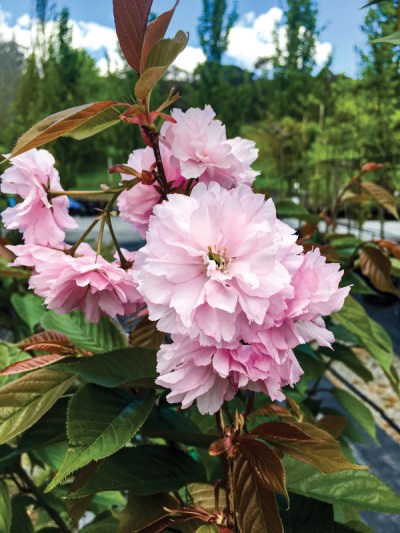
Some fruits trees are self-pollinating (you only need one tree) such as apricots, peaches and plums, and some need another variety of the same fruit tree to be nearby – for example a green and a red apple need each other for cross pollination. Some are partially self-pollinating such as plums and pears.
If you plant carefully, you could have a garden full of blossom for months.
The earliest varieties of fruit trees to blossom in South Australia are flowering quince (a small shrub 1x1m) that produces bright orange/red, pink or white flowers and a weeping apricot that produces beautiful pink blossom. Both bloom in mid/end winter. Generally, the latest to blossom are some varieties of crab apple such as Malus ioensis Plena and Wychwood Ruby.
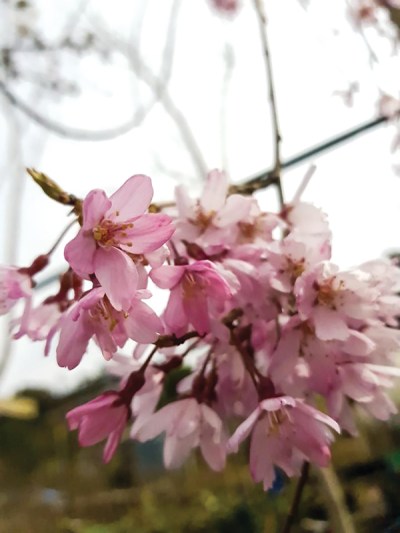
White blossom usually comes from pears, apples, almonds, cherries and citrus. Pink is usually on apricots, peaches, plums, cherries and crab apples.
It’s easy to understand why, in Japan, the whole country gets “cherry blossom fever” when the Sakura (cherry trees) blossom. There is even a word for the art of admiring the blossom: Hanami. The blooming starts in the south (where it is warmer) and gradually, day by day, week by week, moves up the country until it hits the northern island of Hokkaido. Japan has been documenting blooming dates for the past 1200 years, and the accurate records clearly support climate change. The blossoming dates in Kyoto were generally the same for 1000 years, but now they’ve moved by nearly one and half to two weeks as the weather is warmer earlier in the spring.
When referring to blossom flowers you may hear the words “single” and “double” used. A single flower means it has five to eight petals in a single layer, while a double has a double layer of petals and can have up to 30-50 or more petals on a single flower.
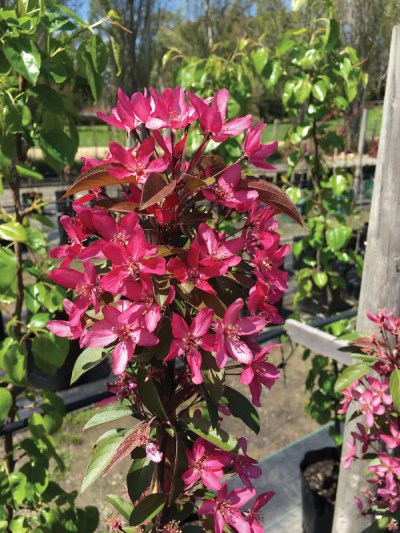
What to plant for the best blossom?
Ornamental cherry
Please note this is a very delicate tree that will not tolerate full sun/hot spots
Weeping varieties
(grafted onto a tall 1.8m or short 1.2m trunk – the head will grow out and cascade down):
Falling Snow/Snow Fountains – white single flower
Subhirtella/Alba – pink bud opening to a single white flower
Cheals – very dense double pink flowers
Rosea – single pink flower
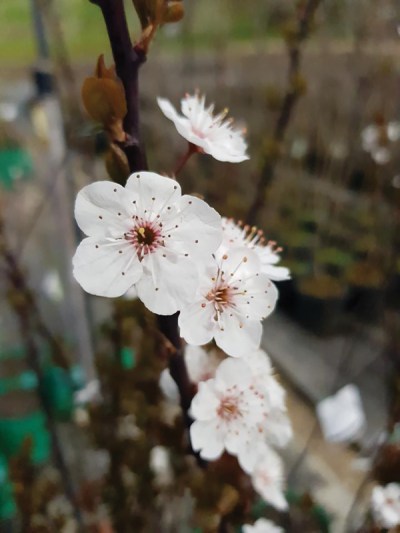
Upright regular tree varieties
Mt Fuji – light pink buds opening to white flowers
Kanzan – stunning huge double pale pink flowers resembling pom poms
Okame – very delicate single pale pink flowers that hang downwards
Crab apples (Malus) – a form of apple tree, these tough small/medium trees have many varieties. Quite often a pink bud will open to a white flower, such as Malus floribunda, Bechtel (Malue ioensis Plena) and Gorgeous.
Pink blossom – Royal Raindrops, Wychwood Ruby and Tom Matthews
Ornamental pears (Pyrus) are very tough, generally all have pink buds that open to white flowers. After a few weeks of blossom a strong wind can blow off all the petals creating a snow-like effect on the ground.
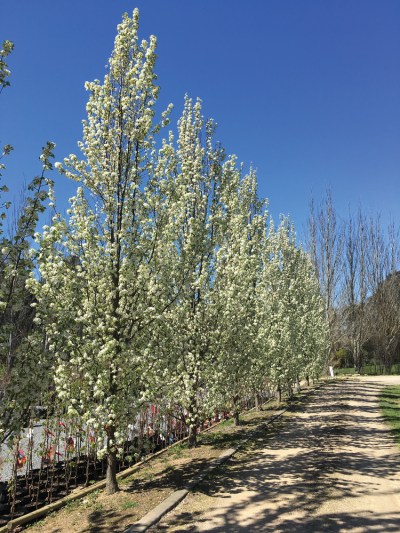
Ornamental plums (Prunus) are very tough, the best variety in Australia for pink blossom is Blireana – masses of double rose-pink flowers that smell lovely.
Prunus Nigra has pale pink single flowers.
Prunus Oakville Crimson Spire is very popular as an upright tree but doesn’t wow with blossom – it produces smaller amounts of white/pale pink flowers.
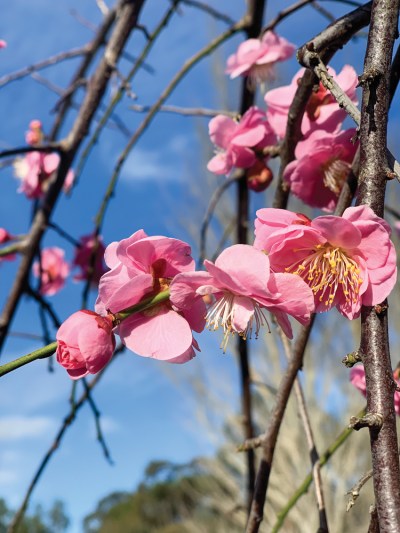
Flowering peaches (Prunus persica) produce stunning blossom – from very hot pink Magnifica to the pale pink of Klara Mayer. However, they are very susceptible to leaf curl and need to be treated with a copper spray accordingly.
Flowering apricots (Prunus mume) are normally the first in the season to flower (even mid winter). Varieties include Splendens and Rosebud and the weeping ‘Pendula’.
Flowering quince (Chaenomeles speciosa) are a very tough small shrub, they flower mid-winter. Colours are white, pink and red/orange.
A blossoming tree makes a wonderful addition to a small or large garden, so be sure to plant it somewhere you can take full advantage of its beauty when it is in bloom. Talk to your local nursery or garden expert to select the right one for your location.
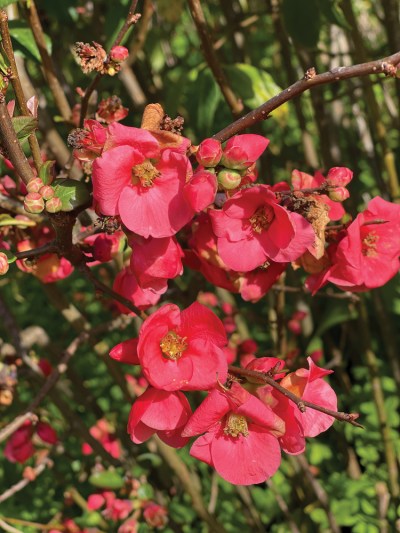
This article first appeared in the Spring 2021 issue of SALIFE Gardens and Outdoor Living magazine.



